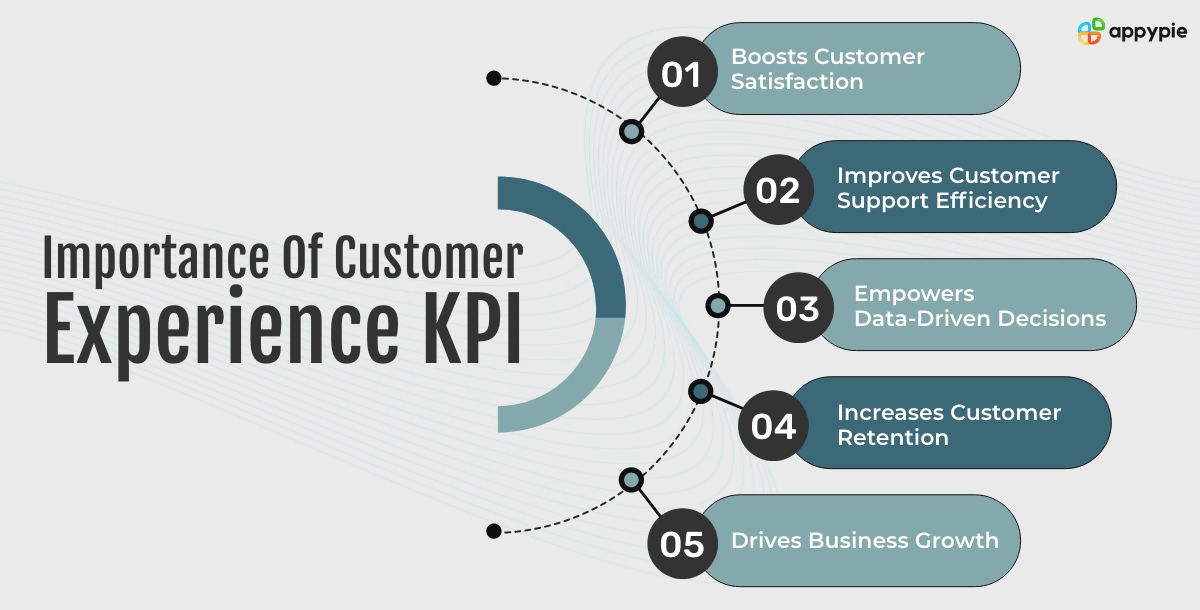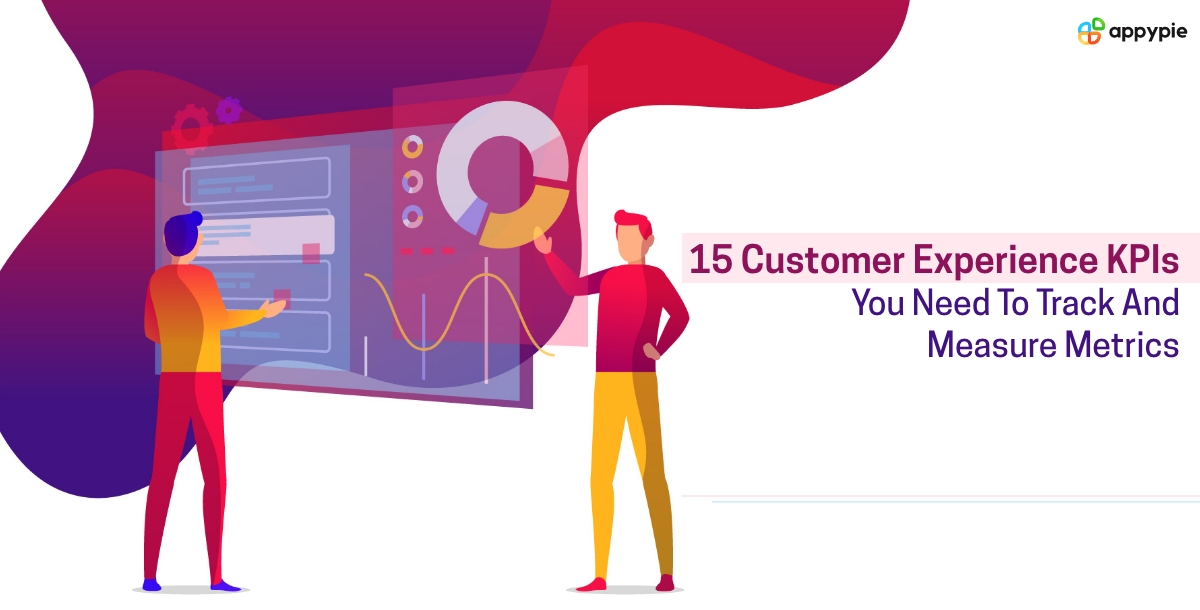15 Customer Experience KPIs You Need To Track And Measure Metrics

In the cutthroat world of business, customer satisfaction reigns supreme. It's the golden thread woven into the fabric of every successful company. After all, happy customers are your biggest advocates, returning for more, singing your praises, and fueling your growth. But how do you gauge this elusive metric of satisfaction? How do you know if your customers are truly having a positive experience?
Enter Customer Experience KPIs (Key Performance Indicators). These quantifiable metrics act as a compass, guiding you through the intricate landscape of your customer's journey with your brand. By tracking these Customer Experience KPIs, you gain invaluable insights into how effectively you're meeting customer needs and identify areas for improvement. This empowers you to refine your product or service, streamline processes, and ultimately craft a frictionless and positive customer experience that keeps your customers coming back for more.
In this guide, we will learn customer experience KPIs, why they matter, and how to use them to optimize user experienceand fuel growth.
Table of Content
What Is Customer Experience KPI
A Customer Experience KPI is a measurable value that tracks how well your business delivers on customer expectations across all touchpoints. These KPIs provide a data-driven way to understand customer satisfaction and identify areas for improvement.
One crucial Customer Experience KPI is the Customer Satisfaction Score (CSAT). This metric measures a customer's level of satisfaction after a specific interaction, such as a purchase or a service call. By tracking CSAT scores, you can gauge the overall health of your customer experience.
Also Read: 8 Critical KPIs For Your App and How to Track Them
15 Best Customer Experience KPIs
Understanding customer satisfaction is key to business success. Customer Experience KPIs (Key Performance Indicators) provide valuable insights to achieve this. Let's explore the top 15 KPIs you should be tracking, along with a detailed explanation for each:
- Customer Satisfaction Score (CSAT)
- Net Promoter Score (NPS)
- Customer Effort Score (CES)
- First Contact Resolution (FCR)
- Average Resolution Time (ART)
- Customer Retention Rate (CRR)
- Customer Churn Rate
- Average Wait Time
- Average First Response Time (FRT)
- Self-Service Rate (SSR)
- Ticket Volume by Channel
- Employee Satisfaction Score (ESAT)
- Cost Per Resolution
- Top Performing Agents
- Customer Lifetime Value (CLV)
This metric gauges a customer's happiness after a specific interaction, like a purchase or service call. Customer satisfaction score or CSAT surveys are typically conducted soon after the interaction and ask customers to rate their satisfaction level. High CSAT scores indicate satisfied customers who are more likely to return and recommend your brand.
Moving beyond satisfaction, NPS measures customer loyalty. It asks a single key question: "On a scale of 0 to 10, how likely are you to recommend our company to a friend or colleague?" Customers are then categorized as Promoters (scores 9-10), Passives (scores 7-8), and Detractors (scores 0-6). A high NPS indicates a strong customer base that actively promotes your brand.
This KPI focuses on ease of use. It tracks how easy it is for customers to resolve issues or complete tasks while interacting with your brand. CES surveys typically ask customers to rate the effort required on a scale (e.g., Very Easy to Very Difficult). A low CES indicates a smooth and effortless customer experience, where customers can find solutions and complete tasks without difficulty.
This metric measures the efficiency of your customer service team. It tracks the percentage of customer issues resolved during the initial interaction with a customer service representative. A high FCR signifies that your team is effectively resolving issues the first time around, minimizing customer frustration and repeat contacts.
Tracks the average time it takes to completely resolve a customer issue. This includes the time it takes for a customer to reach a representative, diagnose the issue, and implement a solution. A lower ART signifies a more efficient customer service operation that can handle inquiries quickly.
This metric measures the percentage of customers who continue using your product or service over a specific period of time. A high CRR indicates successful customer retention strategies, leading to consistent revenue and growth.
The opposite of CRR, this KPI tracks the percentage of customers who discontinue your service within a given timeframe. A low churn rate signifies customer satisfaction and loyalty. Analyzing churn rate alongside other KPIs can help identify areas for improvement to reduce customer loss.
Measures the average time a customer spends waiting to connect with a customer service representative. Long wait times can lead to frustration and negatively impact customer experience. Tracking this KPI helps identify potential bottlenecks in your support channels and optimize staffing to reduce wait times.
Tracks the average time it takes for your customer service team to respond to a customer inquiry, regardless of the channel used (email, chat, etc.). A fast FRT demonstrates responsiveness and a commitment to addressing customer concerns promptly.
Measures the percentage of customer issues resolved through self-service options like FAQs or knowledge bases. A high SSR can reduce the burden on your support team and empower customers to find solutions independently. It's important to ensure your self-service resources are comprehensive and easy to navigate.
This metric identifies the channels customers prefer to use for contacting your support team (phone, email, chat, etc.). Tracking ticket volume by channel helps you allocate resources effectively and ensure adequate support across all channels customers use most.
Measures the satisfaction level of your customer service representatives. Happy and engaged employees are more likely to deliver exceptional customer service. Low ESAT scores might indicate areas for improvement in your company culture, training, or work environment.
Tracks the average cost associated with resolving a customer issue. This includes factors like agent time, resources used, and any applicable discounts or refunds. Analyzing cost per resolution can help identify areas to optimize your support processes and potentially reduce customer service costs.
This metric goes beyond average performance and identifies your most effective customer service representatives. Recognizing and rewarding top performers can motivate your team and ensure consistently high-quality customer interactions.
Measures the total revenue a customer generates for your business over their relationship with your brand. Understanding CLV allows you to focus on strategies to acquire and retain high-value customers who contribute significantly to your business growth.
By consistently monitoring and analyzing these 15 customer experience KPIs, you gain a comprehensive understanding of your customer journey. This empowers you to make data-driven decisions to improve customer satisfaction, optimize your processes, and ultimately fuel business growth through a loyal and happy customer base.
Importance Of Customer Experience KPI

Here's why prioritizing Customer Experience KPIs is crucial for your business:
- Boosts Customer Satisfaction
- Improves Customer Support Efficiency
- Empowers Data-Driven Decisions
- Increases Customer Retention
- Drives Business Growth
Happy customers are loyal customers. By tracking KPIs like Customer Satisfaction Score (CSAT), you can identify areas for improvement and ensure your customers have positive interactions across all touchpoints, from browsing your website to interacting with your help desk.
Customer Experience KPIs like Average Resolution Time (ART) and First Contact Resolution (FCR) help you measure the efficiency of your customer support team. By analyzing these metrics, you can identify bottlenecks in your support processes and optimize your use of tools like live chat software or help desk software to streamline issue resolution.
Customer Experience KPIs provide valuable data insights that go beyond gut feelings. This data can inform strategic decisions about your customer service strategy, such as implementing a customer service chatbot to answer common questions or investing in a comprehensive knowledge base software to empower self-service.
By focusing on improving customer experience, you can significantly reduce customer churn. By addressing customer pain points identified through Customer Experience KPIs, you can encourage customers to stay with your brand for the long haul.
Happy customers are not only more likely to return, but they're also more likely to recommend your brand to others. By prioritizing Customer Experience KPIs, you can cultivate a loyal customer base that fuels sustainable business growth.
Remember, Customer Experience KPIs are just one piece of the puzzle. By combining these metrics with customer feedback and a commitment to continuous improvement, you can create a customer-centric culture that sets your business apart.
Also Read: 72 Essential Ecommerce KPIs You Must Know
Conclusion
The greatest indicators of how your brand or product is performing are found within your Customer Experience KPIs. Here at Appy Pie, we understand the importance of exceptional customer service. That's why we offer the best help desk software and ticketing system to empower you to deliver outstanding customer experiences. Let Appy Pie help you translate happy customers into business growth!
Related Articles
- Make Money Watching Ads (5 Websites That Pay YOU to Watch Ads)
- Data Alignment for Zero-Shot Concept Generation in Dermatology AI
- Top 5 Microsoft Exchange Integrations For Your Business
- How Property Dealers Can Boost Up Their Revenue with a Real Estate App?
- Plot2Code: A Comprehensive Benchmark for Evaluating Multi-modal Large Language Models in Code Generation from Scientific Plots
- Personalized Residuals and Localized Attention-Guided Sampling for Efficient Concept-Driven Generation in Text-to-Image Diffusion Models
- How to Freeze Columns in Google Sheets?
- Looking 3D: Anomaly Detection with 2D-3D Alignment
- Lime Green Color: Meaning, Similar Colors & How to Create Design using Lime Green Color
- Guide to Custom Apple Watch Faces & DIY App Development
